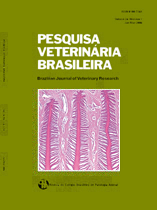 |
|
|
|
Year 2014 - Volume 34, Number 1
|

|
Non-parturient hypocalcaemia in lactating dairy cows grazing in oat and perennial ryegrass pasture: study of predisposing factors, 34(1):15-23
|
ABSTRACT.- Coneglian M.M., Flaiban K.K.M.C. & Lisbôa J.A.N. 2014. [Non-parturient hypocalcaemia in lactating dairy cows grazing in oat and perennial ryegrass pasture: study of predisposing factors.] Hipocalcemia não puerperal em vacas leiteiras sob pastejo de aveia e azevém: estudo de fatores predisponentes. Pesquisa Veterinária Brasileira 34(1):15-23. Departamento de Clínicas Veterinárias, Centro de Ciências Agrárias, Universidade Estadual de Londrina, Campus Universitário, Cx. Postal 10011, Londrina, PR 86057-970, Brazil. E-mail: janlisboa@uel.br
Non-parturient hypocalcaemia (NPH) is a rare and poor understood condition. There are no studies that explain its relationship with winter pasture intake. The aim of this study was to describe clinical aspects of two natural cases of NPH, and to study the mineral and electrolyte balance of high and medium producing dairy cows feeded with winter pasture in different growing stages. Two cases of NPH in lactating dairy cows, grazing in oat grass and perennial ryegrass in Francisco Beltrão, PR, Brazil, were described. Healthy lactating high producing Holstein cows (n=11) and medium producing Holstein (n=8) and Jersey (n=9) cows were selected from three farms located in the same municipality. They were maintained in a mixing pasture of oats and perennial ryegrass from June to October, and supplemented with corn silage. Blood, urine and ingested food samples were collected before treatment started (May), and during initial (June), intermediate (July) and final stages (September) of the grass maturation cycle. Serum and urinary concentrations of Ca, P, Mg, Na+, K+, Cl- and creatinine were determined, and their fractional excretion were calculated. Dry matter and Ca, P, Mg, Na, K, Cl and S concentrations were determined in food samples, and the dietary cation-anion difference was calculated. Based on clinical evidence we can assure that lactating dairy cows maintained in oat and perennial ryegrass pastures during the winter months can develop hypocalcaemia, showing signs and responding to treatment similar to classic puerperal hypocalcaemia, even in non-parturient period. Partial substitution of corn silage to oat and perennial ryegrass pasture did not cause electrolyte imbalances and did not interfere with the calcemia, phosphatemia or magnesemia of high and medium producing lactating dairy cows. Using winter forage as the only or main source of roughage in the diet can be the triggering factor for the disease, which can be related to excessive cation intake due to increased K concentration, especially during early stages of pasture growing. |
| |
|
|
| |
|
 |